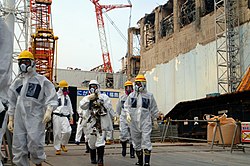Human impact on the environment
observed or potential changes to biophysical environments and ecosystems caused directly or indirectly by humans, including global warming, environmental degradation, mass extinction and biodiversity loss, ecological crisis and collapse From Wikipedia, the free encyclopedia
Remove ads
Human activities have changed the environment in many ways. Over time, as the population has grown and technology has advanced, people have used more land, water, and natural resources. These actions have caused problems for the Earth’s air, land, water, animals, plants, and climate.
Human impact on the environment. From top left, clockwise: satellite image of Southeast Asian haze; IAEA experts investigate the Fukushima disaster;. a seabird during an oil spill; slaves clearing the Brazil's Atlantic forest on behalf of the Portuguese settlers, c. 1820–1825; acid mine drainage in the Rio Tinto; industrial fishing in 1997, a practice that has led to overfishing.
One of the biggest effects of human activity is climate change. People burn fossil fuels like coal, oil, and gas for energy in cars, factories, and homes. This releases gases like carbon dioxide and methane into the air. These gases trap heat in the atmosphere and make the Earth warmer. As the planet gets hotter, glaciers melt, sea levels rise, and extreme weather becomes more common. This includes more heatwaves, floods, droughts, and storms.
Humans have also changed the land. Forests are cut down to make space for farms, roads, and cities. This is called deforestation. When trees are removed, animals lose their homes and the soil becomes weaker. Forests help clean the air and store carbon, so losing them makes climate change worse. Farming and building can also break up land into smaller parts, which harms wildlife and makes it harder for animals to survive.
Water use is another big issue. People need water for drinking, farming, and industry, but in many places, water is being used faster than it can be replaced. In addition, human actions pollute rivers, lakes, and oceans. Farms use chemicals that wash into water sources. Factories and cities release waste into rivers. This pollution can make water unsafe for people and animals. In oceans, pollution and overfishing reduce fish populations and hurt sea life.
Air pollution is caused by burning fuels, using chemicals, and producing waste. Dirty air can cause health problems for people, such as asthma and heart disease. It also damages plants and animals. In some areas, smog and smoke make it hard to breathe and see clearly.
Soil is affected too. Farming can use up important nutrients in the soil. Cutting down trees and overgrazing by animals can cause erosion, which means the soil is washed or blown away. Some chemicals used on farms can also poison the land, making it harder for plants to grow.
As people use more resources, many animals and plants are disappearing. This is called loss of biodiversity. When forests, wetlands, and other habitats are destroyed, the species that live there may die out. Hunting, pollution, climate change, and bringing new species into ecosystems also harm wildlife. Some scientists believe the Earth is going through a mass extinction caused by human actions.
Noise and light from cities and machines also affect the environment. Loud sounds from boats or machines in the ocean can confuse whales and dolphins. Bright lights in cities can disturb birds and other animals that depend on darkness to live and hunt.
Although humans have caused many of these problems, people can also help fix them. Using clean energy sources like wind and solar power can reduce pollution and greenhouse gas emissions. Protecting forests, recycling, using less water, and creating parks and wildlife areas can help nature recover. Making better choices about what we eat, how we travel, and how we use resources can reduce harm to the environment.
Remove ads
Wikiwand - on
Seamless Wikipedia browsing. On steroids.
Remove ads






